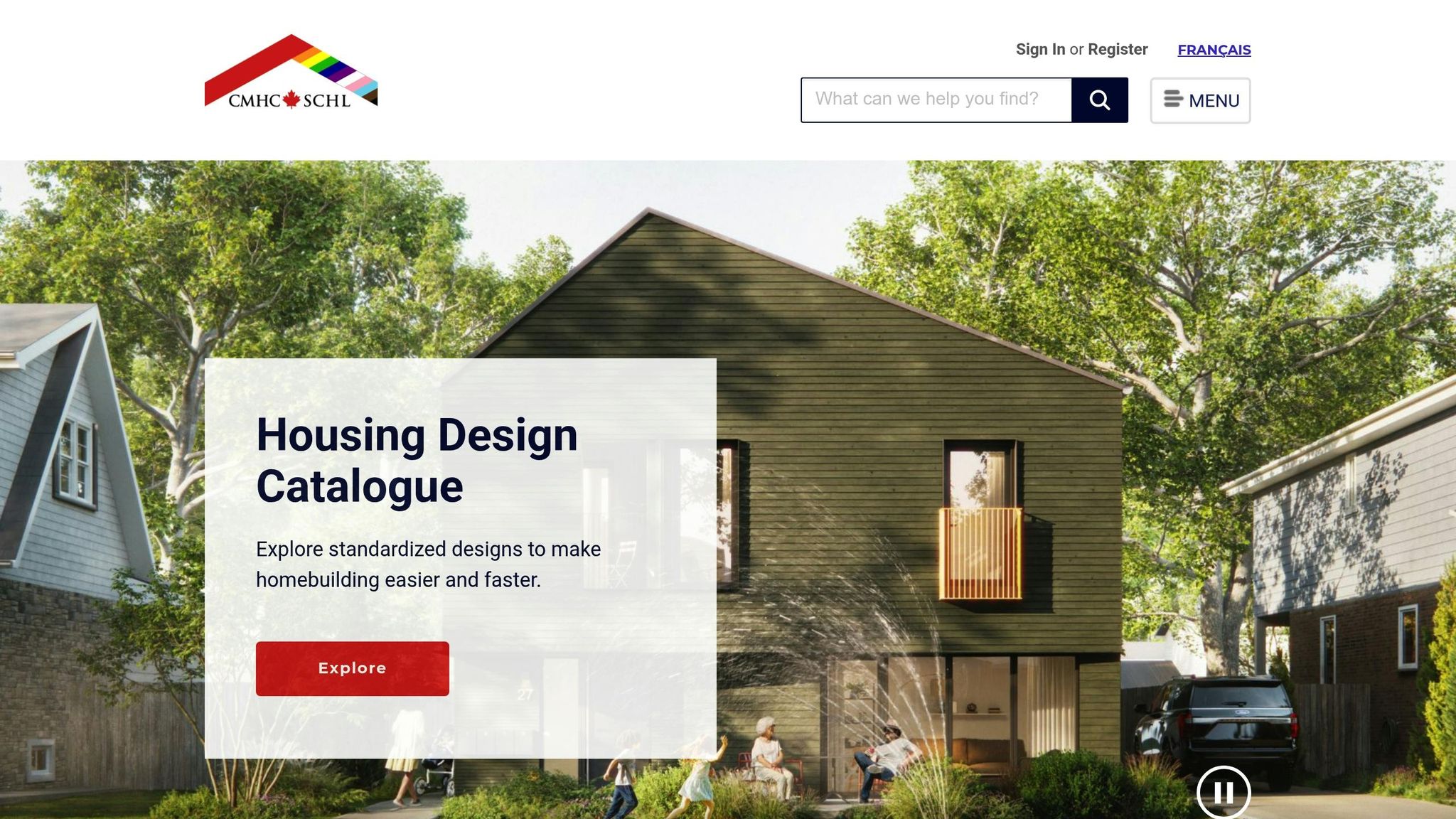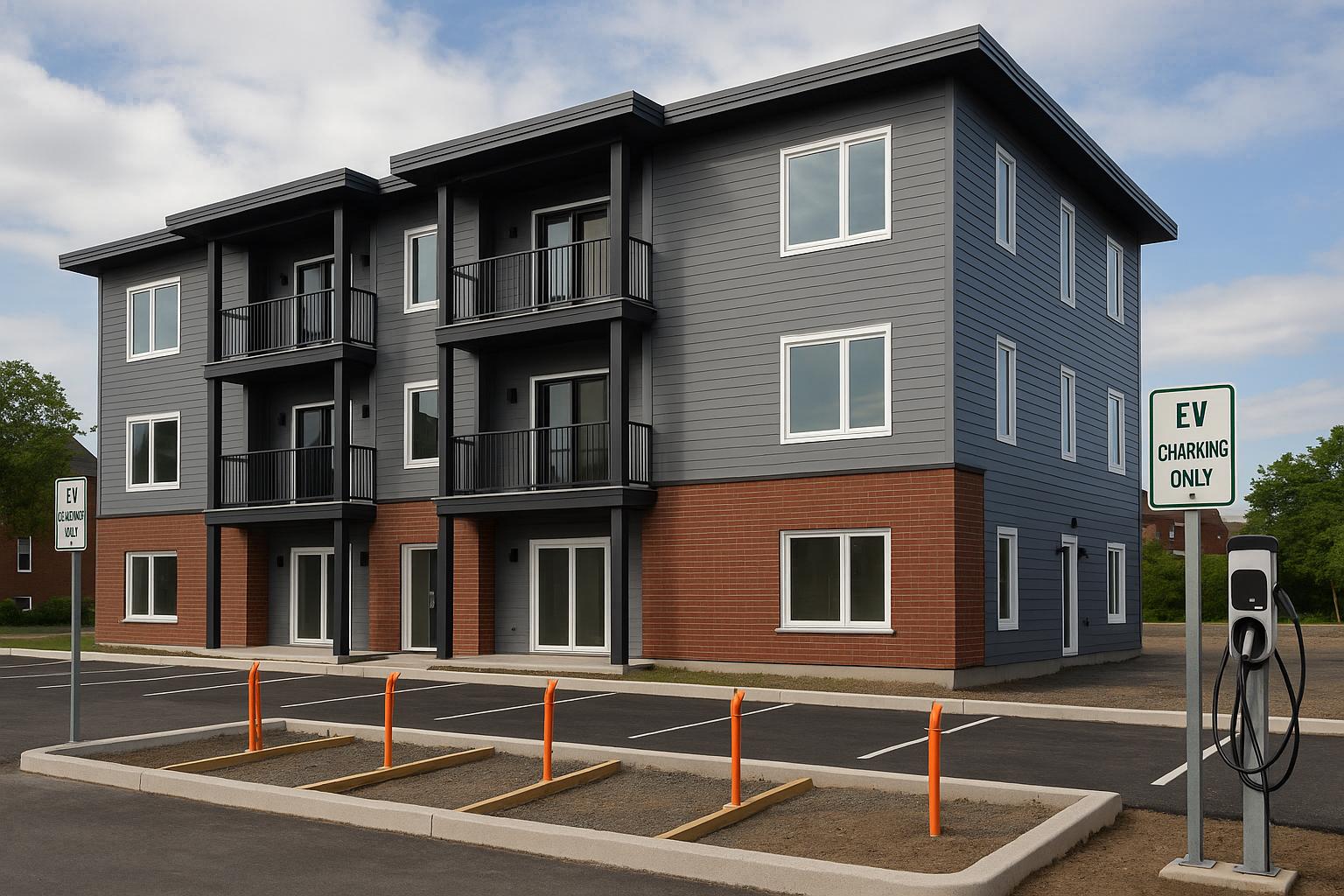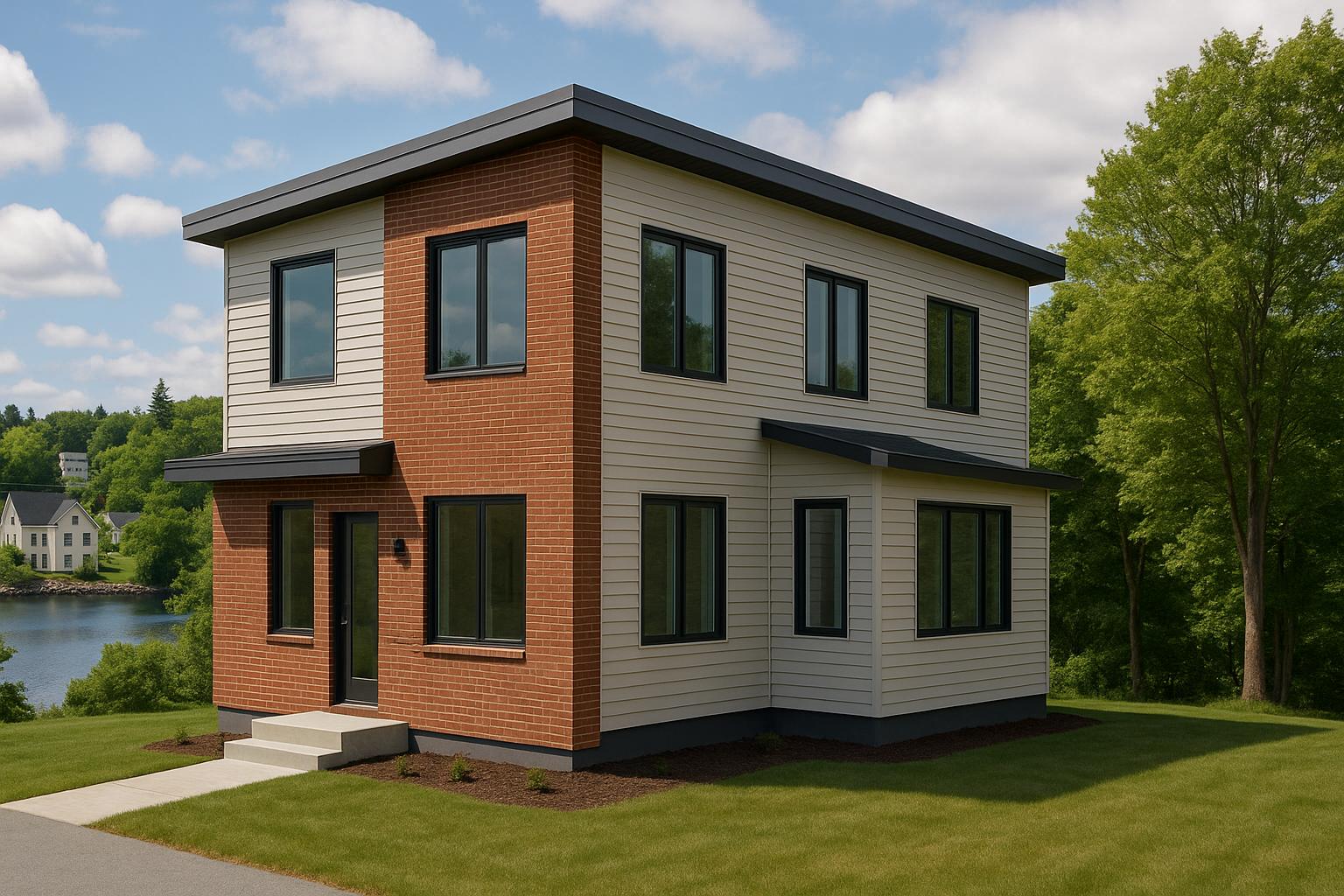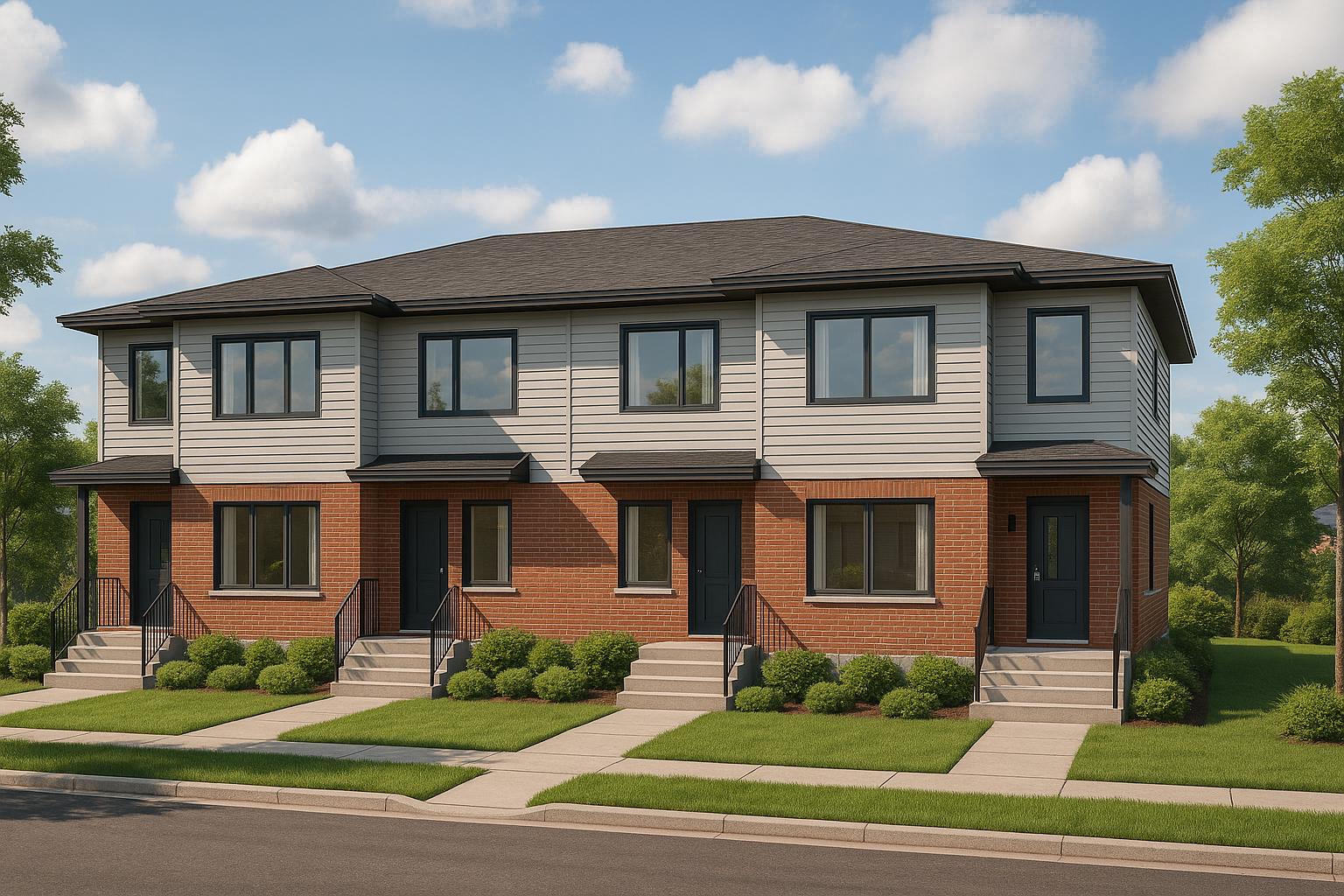Halifax’s Centre Plan has reshaped urban housing through ER-3 zoning, enabling multi-unit residential developments that fill the gap between single-family homes and large apartment complexes. Early ER-3 projects have revealed key strategies for success, including adopting integrated construction models, leveraging CMHC MLI Select financing, and prioritizing quality finishes to meet market demand. Developers have reported construction costs of $160,000–$200,000 per unit, with rental income for two-bedroom units ranging from $1,950 to $2,100 per month and annual returns between 12% and 20%.
Key Takeaways:
- ER-3 Zoning Rules: Allow multi-unit dwellings with clear guidelines for size, height, and community fit.
- Integrated Construction Models: Simplify coordination, reduce delays, and ensure fixed budgets.
- CMHC Financing: Offers up to 95% financing with 50-year amortization for eligible projects.
- Challenges: Zoning delays, heritage requirements, and cost overruns with fragmented construction methods.
- Solutions: Early planning, fixed-price contracts, and premium finishes to attract tenants and maximize ROI.
Early ER-3 developers highlight the importance of careful planning, streamlined construction, and market-aligned designs to meet Halifax’s growing demand for mid-density housing.
Halifax Wants URGENT CHANGES to Planning Rules for Housing
ER-3 Zoning Rules in Halifax
Halifax's ER-3 zoning provides a clear framework for property owners interested in developing multi-unit rental properties. These guidelines aim to balance the area's existing character with opportunities for new development. By simplifying the approval process, the rules ensure that projects align with the community's needs and aesthetic.
ER-3 Zoning Requirements
ER-3 zoning permits the construction of multi-unit dwellings, but specific rules govern the size, height, and setbacks of these buildings. These parameters are designed to maintain the residential feel of the neighbourhood. Developers must also meet requirements for parking and amenity spaces, ensuring that new developments are functional and considerate of their surroundings. Additionally, design standards encourage the use of high-quality materials and architectural features that blend seamlessly with nearby homes.
Changes from Previous Zoning
The shift to ER-3 zoning marks a significant departure from earlier rules. Previously, properties were often limited to single-family homes or duplexes, and approval processes were more cumbersome. With ER-3, multi-unit buildings are now allowed by default, making it easier for property owners to increase density. The new rules also offer more flexibility in terms of lot coverage, enabling better use of existing properties.
Heritage Zones and Project Impact
For properties within Heritage Conservation Districts, additional design requirements come into play to safeguard the area's historical significance. These guidelines can affect both project timelines and costs, so consulting with heritage planners early in the process is essential. Developers who thoughtfully incorporate heritage elements into their designs often create projects that not only respect the neighbourhood's history but also enhance its appeal, potentially leading to stronger rental demand and returns.
Case Studies: Early ER-3 Multi-Unit Rental Developments
Halifax's ER-3 zoning framework has created new possibilities for property owners to convert single-family lots into multi-unit rental properties. These early projects have provided key insights into how design, construction, and financing strategies can align with zoning requirements while maximizing profitability.
Project Details and Results
In Halifax's South End, several early ER-3 projects successfully converted single-family lots into fourplexes. The average construction cost for these developments was approximately CAD $160,000 per unit, with two-bedroom units renting for CAD $1,950 to $2,100 per month. Some developers chose to follow CMHC MLI Select construction standards, investing around CAD $200,000 per unit to secure better financing terms. With careful management, these projects reported annual returns between 12% and 20%, offering a strong financial incentive for similar developments. These results highlight the potential of ER-3 projects while also exposing challenges tied to traditional construction methods.
Problems and Solutions in ER-3 Projects
Early ER-3 developments faced several hurdles, particularly with traditional construction practices. Zoning and permitting delays were common, and using multiple contracts often led to coordination issues, cost overruns, and project delays. In areas governed by heritage guidelines, some developers encountered setbacks when designs didn’t align with heritage requirements, leading to costly revisions. Early consultation with heritage planners emerged as an effective way to avoid these pitfalls.
On the other hand, projects using an integrated construction model, where design, engineering, and construction were managed under a single contract, experienced fewer delays and reduced risks. This approach proved to be a game-changer for ensuring smoother project execution.
What Early Developers Learned
The experiences of these early developers revealed several strategies for overcoming challenges and improving overall outcomes. Key takeaways included:
- Adopting an integrated design-build model to simplify coordination and reduce risks.
- Using fixed-price construction contracts to maintain strict budget control and avoid financial surprises.
- Implementing daily photo updates and progress reports to quickly address any issues that arise during construction.
- Scheduling multiple inspection points and independent final reviews to ensure both structural integrity and aesthetic quality.
- Planning realistic timelines with guaranteed completion dates to maintain steady cash flow.
- Navigating CMHC MLI Select financing processes to improve cash flow and leverage for future projects.
Ultimately, these lessons emphasized the importance of integrating design and construction within a single, accountable team. This approach not only streamlines project management but also plays a critical role in maximizing long-term financial returns.
Integrated vs Traditional Construction Methods
Insights from early ER-3 projects in Halifax reveal how the choice of construction methodology can significantly affect project outcomes. These projects demonstrate that property owners who choose an integrated construction approach often benefit from fewer delays, better budget management, and smoother project completion when compared to the fragmented nature of traditional methods. For ER-3 developers aiming to maximise returns, these differences are key.
Construction Model Differences
Here's a breakdown of how traditional and integrated construction methods differ:
| Factor | Traditional Construction | Integrated Construction |
|---|---|---|
| Project Coordination | Requires multiple contracts with separate architects, engineers, contractors, and specialists | Operates under a single contract with a unified design-build team |
| Budget Certainty | Relies on cost-plus pricing, often leading to overruns of 30–60% | Uses fixed-price contracts set before construction begins |
| Timeline Guarantees | Projects planned for 6–8 months can stretch to 18+ months, delaying rental income | Guarantees six-month completion with CAD $1,000 per day penalty for delays |
| Quality Assurance | Independent inspections can result in inconsistent quality control | Ensures consistent quality under unified accountability |
| Communication | Property owners must coordinate with multiple parties, increasing the risk of miscommunication | A single point of contact oversees the entire project |
This comparison highlights how the integrated model simplifies project execution and addresses many of the inefficiencies common in traditional construction. These distinctions also help explain why property owners often encounter difficulties with the traditional approach.
Why Property Owners Face Challenges with Traditional Builders
Traditional construction methods place a heavy coordination burden on property owners. They must manage separate architects, engineers, and contractors, which increases the risk of miscommunication and delays. Additionally, the cost-plus pricing model leaves owners vulnerable to unexpected cost hikes due to fluctuating material and labour prices or changes in project scope. Without a centralised point of accountability, aligning timelines becomes a challenge, often delaying completion and occupancy, which directly impacts rental income.
Benefits of Integrated Construction for ER-3 Projects
The integrated construction model eliminates these pain points by bringing all project roles - designers, engineers, and builders - under one contract. This approach simplifies communication from the start, ensuring that everyone is on the same page. Fixed-price contracts provide budget certainty, as the builder assumes the risk of cost overruns. Moreover, guaranteed completion dates with financial penalties for delays ensure that timelines are treated as firm commitments.
This unified approach not only improves quality control but also ensures that ER-3 projects align with zoning requirements and market expectations. By addressing these critical factors, integrated construction helps developers maximise returns while maintaining regulatory compliance.
sbb-itb-16b8a48
Maximizing ROI and Meeting ER-3 Requirements
Developing ER-3 properties in Halifax requires a thoughtful approach to balancing construction costs, potential rental income, and strict adherence to zoning requirements. Property owners who grasp these financial and regulatory dynamics early on set themselves up for better returns and smoother project execution. By combining these financial strategies with an integrated construction model, developers can achieve both compliance and profitability.
Construction Costs and Rental Income Targets
Completed ER-3 projects in Halifax typically show construction costs ranging from $160,000 to $200,000 per unit. This budget covers high-quality features like ductless heat pumps, triple-pane windows, quartz countertops, and engineered hardwood flooring. These premium finishes support rental rates of $1,950 to $2,100 per month for two-bedroom units.
This pricing aligns with Halifax's current rental market and allows for annual ROI projections between 12% and 20%. The trick to maximizing returns lies in finding the sweet spot: keeping construction costs under control while delivering a level of quality that justifies premium rents. Cutting corners can diminish tenant appeal, while overbuilding leads to unnecessary expenses - both of which can hurt profitability.
Using CMHC Financing Programs

In Canada, the Canada Mortgage and Housing Corporation (CMHC) is the only provider of mortgage loan insurance for multi-unit residential properties, making its programs a key tool for ER-3 developers [1]. The MLI Select program is particularly appealing, offering favourable terms for those who meet specific requirements.
Under MLI Select, developers can secure up to 95% financing with just a 5% down payment and benefit from 50-year amortization periods - a stark contrast to the typical 20% down payment and 25-year terms. To qualify, projects must meet standards for affordability, accessibility, and energy efficiency.
Quality Control and Project Transparency
Quality control is essential for the success of any ER-3 project, starting with material selection and architectural planning [2]. According to Dan Leising, VP of Business Development at Renu:
"Maintaining stringent quality control throughout the construction process is not just a best practice - it's essential for ensuring durability, safety, and tenant satisfaction."
- Dan Leising, VP of Business Development, Renu [2]
Rigorous inspection protocols are applied throughout the construction process to ensure compliance with ER-3 zoning requirements and industry standards [2][3]. Tools like advanced project management software allow for real-time tracking, while technologies such as drones and 3D scanning provide detailed site visuals to quickly identify and address any issues [2].
Regular visual updates and scheduled inspections ensure that any problems are corrected without delay. As Renu emphasizes:
"Clear and consistent communication between all parties - contractors, subcontractors, suppliers, and clients - ensures that everyone is informed about the project's status."
- Renu [2]
Dedicated quality managers, advanced tracking systems, and thorough post-construction reviews ensure compliance with ER-3 standards, while also boosting tenant satisfaction. Detailed documentation of materials and processes further supports accountability and adherence to Nova Scotia Building Code regulations [4].
Lessons and Recommendations for Future ER-3 Developers
The experiences of early ER-3 adopters in Halifax's Centre Plan offer valuable insights into the challenges and opportunities of multi-unit rental development. These lessons provide a foundation for practical strategies that can help future developers succeed.
Key Lessons from Early ER-3 Success Stories
Early projects highlighted several challenges in traditional construction methods, but those that thrived shared common traits. A standout factor was the importance of early planning and municipal engagement. Developers who took the time to understand heritage zone requirements and setback regulations avoided expensive redesigns and delays later in the process.
Another critical takeaway was the advantage of integrated construction models. Projects that used fixed-price contracts with integrated timelines were completed faster and stayed within budget. In contrast, fragmented construction approaches led to cost overruns ranging from 30-60%. This difference often determined whether a project met the desired 12-20% annual ROI or fell short.
Quality control systems also played a crucial role in long-term success. Developers who implemented thorough inspection protocols and maintained detailed documentation were better positioned to attract high-paying tenants. For instance, properties with superior quality standards were able to charge $1,950-$2,100 per month for two-bedroom units. On the other hand, cutting corners on quality often resulted in lower rental income and difficulty filling units.
Practical Tips for New ER-3 Developers
Drawing from these lessons, future ER-3 developers can adopt several strategies to enhance their chances of success:
- Evaluate financial viability early. Before diving into an ER-3 project, conduct a realistic financial assessment. If you're considering financing through CMHC MLI Select programs, ensure your project meets the required energy efficiency standards. These programs, offering up to 95% financing with just a 5% down payment, can significantly improve cash flow, but the application process can be time-intensive.
- Opt for integrated construction models. Choosing builders who offer fixed-price contracts with guaranteed timelines and financial penalties for delays can make a significant difference. This approach minimizes risks and helps keep your project on track.
- Monitor progress closely. Insist on daily updates and real-time tracking during construction. Even small issues can snowball into major delays or cost overruns if not addressed promptly.
- Invest in premium finishes. Features like ductless heat pumps, triple-pane windows, and quartz countertops may increase upfront costs but are essential for attracting tenants in Halifax's competitive rental market. These upgrades can justify higher rents and improve tenant satisfaction.
- Understand your local market. Halifax's current construction cost range of $160,000-$200,000 per unit works well in the city's rental environment, but it's crucial to ensure these numbers align with your specific location and target demographic. Research comparable rental rates in your area to avoid overcommitting on construction costs.
The most successful ER-3 developers approach their projects as strategic business investments. By planning thoroughly, selecting reliable partners, and maintaining strict oversight, they consistently achieve their financial goals while avoiding the pitfalls that have hindered others.
FAQs
What are the main advantages of using an integrated construction model for ER-3 zoning projects in Halifax?
Why Use an Integrated Construction Model for ER-3 Projects in Halifax?
Adopting an integrated construction model for ER-3 projects in Halifax comes with some clear perks. First, it offers cost predictability - a major win for property owners trying to stick to their budget and avoid surprise expenses. By streamlining the process, this model helps keep finances in check.
It also boosts efficiency, cutting down on delays and ensuring projects wrap up on schedule. No more waiting around for things to fall into place.
Another big advantage? It reduces risks. Thanks to its systematic delivery, this approach eliminates many of the uncertainties tied to traditional, fragmented construction methods. The result? Faster completion times and better-quality outcomes. For property owners looking to get the most out of their investment in multi-unit developments under Halifax's Centre Plan, this model is a smart choice.
How does the CMHC MLI Select program make ER-3 rental developments more financially viable?
The CMHC MLI Select program provides a financial boost for ER-3 rental developments, making them more manageable by cutting financing costs and promoting affordability. It offers reduced mortgage insurance premiums and longer amortization periods, which help lower monthly payments and improve cash flow.
These advantages allow property owners to handle budgets more effectively while enhancing the profitability of multi-unit rental projects under Halifax's Centre Plan ER-3 zoning. By utilizing this program, developers can address financing hurdles while keeping their projects financially sustainable and compliant.
What are the best strategies for ER-3 developers in Halifax to address heritage zoning challenges?
Navigating Heritage Zoning in Halifax’s ER-3 Areas
When planning a project in Halifax's ER-3 zones, addressing heritage zoning requirements can feel like a puzzle. The best starting point? Engage with local heritage authorities early on. This step helps you understand preservation guidelines and sets the stage for a smoother process.
Looking into adaptive reuse options is another effective strategy. By creatively repurposing heritage elements, you can maintain the character of the property while introducing modern multi-unit designs. It's a win-win for preservation and progress.
To meet regulations without sacrificing the charm of heritage features, ensure your plans incorporate fire safety, accessibility, and structural standards from the outset. A design that balances compliance with preservation is more likely to gain approval.
Collaborating with heritage advisory committees can also make a big difference. Their input not only helps refine your project but might also unlock potential incentives if heritage designations are involved.
The key to success in ER-3 zoning? Stay proactive. By balancing heritage preservation with modern development needs, you can navigate challenges and achieve a project that respects the past while embracing the future.



